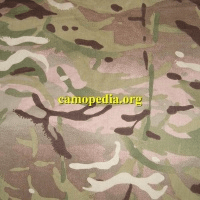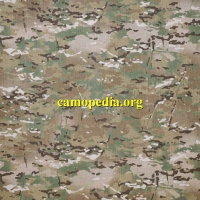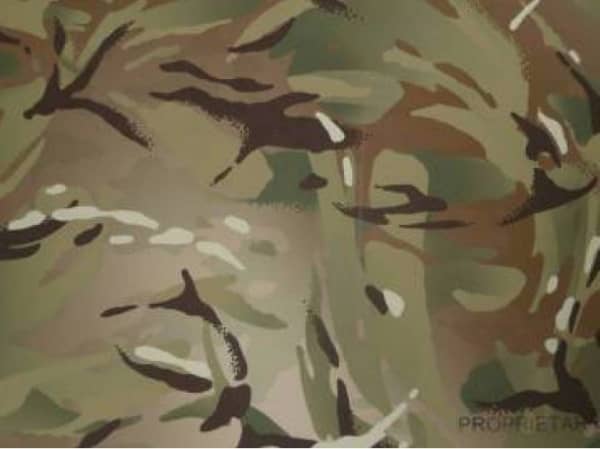Camouflage pattern MTP - Multi-Terrain Pattern
Lessons learned by British forces in Afghanistan led to the addition of a new camouflage pattern to their army: the Multi Terrain Pattern / MTP type, introduced in 2010. It is a hybrid between Crye Multicam and traditional DPM. It is a pattern that is copyright protected by the British MoD.

What does the Crye Multicam camouflage pattern look like?
The term “MultiCam” refers to a design originally developed for the U.S. army as a joint project by local organizations Crye Precision and US Army Natick Laboratories. The aim of this camouflage pattern was to adequately conceal its wearer during operations across different seasons and locations worldwide simultaneously. This would eliminate the need for multiple camouflages in army production, which is always a logistical nightmare for people in the field and behind enemy lines. During the testing phase (“US Army Uniform Trials”, which took place in 2004), this camouflage was called “Scorpion”. A slightly modified version of this design became known as “MultiCam” once Crye brought it to market. Although this type was not immediately incorporated into the official U.S. arsenal after the camouflage pattern tests in the summer of 2004, some special units of the U.S. army used it, and reports on its practical performance were decidedly positive. These positive responses undoubtedly contributed to the adoption of MultiCam in 2010 by the standard U.S. Army, which deployed its members to operations in Afghanistan. According to official terminology, the early worn version of MultiCam was named OCP or “Operation Enduring Freedom Camouflage Pattern”.
The “MultiCam” camouflage series is currently widely available across the global market, as it is produced under license by numerous manufacturers (and even in illegal form by some Asian fabric and clothing producers). Around 2013, several conventional, or at least special forces worldwide, adopted one or more versions of this camouflage pattern and began using it. Countries using some versions of MultiCam include: Australia, Chile, Georgia, the Maldives, the Netherlands, New Zealand, and Panama. It was also adopted in Denmark, where it replaced the long-standing M84 type. A variation was also licensed to Montenegro. Polish forces adopted a MultiCam variation called “Suez”, which is commercially produced locally under the name “CamoGrom”. MultiCam also forms the basis for the British MTP (British Armed Forces Multi-Terrain Pattern - MTP), although this version also incorporates traditional elements of “Disruptive Pattern Material DPM”.

How did England implement the new Multi-Terrain Pattern camouflage?
It's been about ten years since the world of camouflages and concealments reached an interesting historical crossroads. England concluded that their legendary DPM concealment should be replaced with MTP/Multi-Terrain Pattern after forty years of dependable service.
At this time, the U.S. was still in the midst of its trials and analyses (on generally improving concealment quality for all in Afghanistan and other similar global warfields), but Britain evidently approached this matter more pragmatically, advancing its camouflage history with the help of Crye Precision.
According to data posted on MilitaryPhotos.net in 2009, the information is as follows: the British Armed Forces will be equipped with combat uniforms featuring a camouflage pattern optimized for the environment in Afghanistan as well as various other settings:
- It will be used by personnel deployed in Operation HERRICK from March 2010 and then issued to all members of the British Armed Forces from 2011 onward.
- This is the first time in forty years this army has decided to change its camouflage, with operational effectiveness in the given area being the primary reason for this decision.
- The camouflage is multi-terrain and was developed after years of testing, scientific experiments, and rigorous evaluation. It is a camouflage that performs consistently well across a wide range of environments, places, and seasons, both locally and globally.
During the tests, all camouflage patterns were evaluated in various locations (England, Cyprus, Kenya, Afghanistan, etc.) by the “Infantry Trials and Development Unit (ITDU)”. Both in-service camouflage patterns and potential new ones, as well as those commonly available on the market, were tested. The tests involved direct visual comparisons, the time necessary to locate different camouflages on various backgrounds, and subjective opinions from their wearers.
As it turned out, Crye Multicam® technology-equipped items performed significantly well across many sections, even with a substantial lead. It is no wonder that this camouflage pattern was chosen as the basis for England's new camouflage type. Traditionalists can rest easy – their new type also includes elements of the traditional UK DPM pattern. The new hybrid version will continue to be called – Multi-Terrain Pattern (MTP).
It is an item with a U.S. patent, and the situation is no different in Europe.

As you can see for yourself, the connection between DPM and MultiCam is evident and apparent, and perhaps the only compromise with which local patriots and innovators will be at least somewhat satisfied.






































































































































